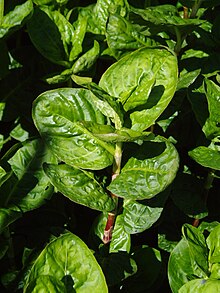Persicaria tinctoria
| Persicaria tinctoria | |
|---|---|

| |
| Scientific classification | |
| Kingdom: | Plantae |
| Clade: | Tracheophytes |
| Clade: | Angiosperms |
| Clade: | Eudicots |
| Order: | Caryophyllales |
| Family: | Polygonaceae |
| Genus: | Persicaria |
| Species: | P. tinctoria |
| Binomial name | |
| Persicaria tinctoria | |
| Synonyms[1] | |
| |
Persicaria tinctoria is a species of flowering plant in the buckwheat family. Common names include Chinese indigo, Japanese indigo and dyer's knotweed.[2][3][4] It is native to Eastern Europe and Asia.
The leaves are a source of indigo dye. It was already in use in the Western Zhou period (c. 1045 BC – 771 BC), and was the most important blue dye in East Asia until the arrival of Indigofera from the south.
See also
References
- ^ Persicaria tinctoria. The Plant List.
- ^ Japanese Indigo Polygonum tinctorium also called: Persicaria tinctoria
- ^ An Impartation of Color: Japanese Indigo (Polygonum tinctorium) – leaves
- ^ "Dye seeds Japanese indigo, Polygonum tinctorium". Archived from the original on 2023-06-05. Retrieved 2023-08-23.
[...] Japanese indigo or dyer's knotweed is a plant that contains indigo precursors in the green leaves.
Gallery
- Traditional natural dyeing (Korean blue)

